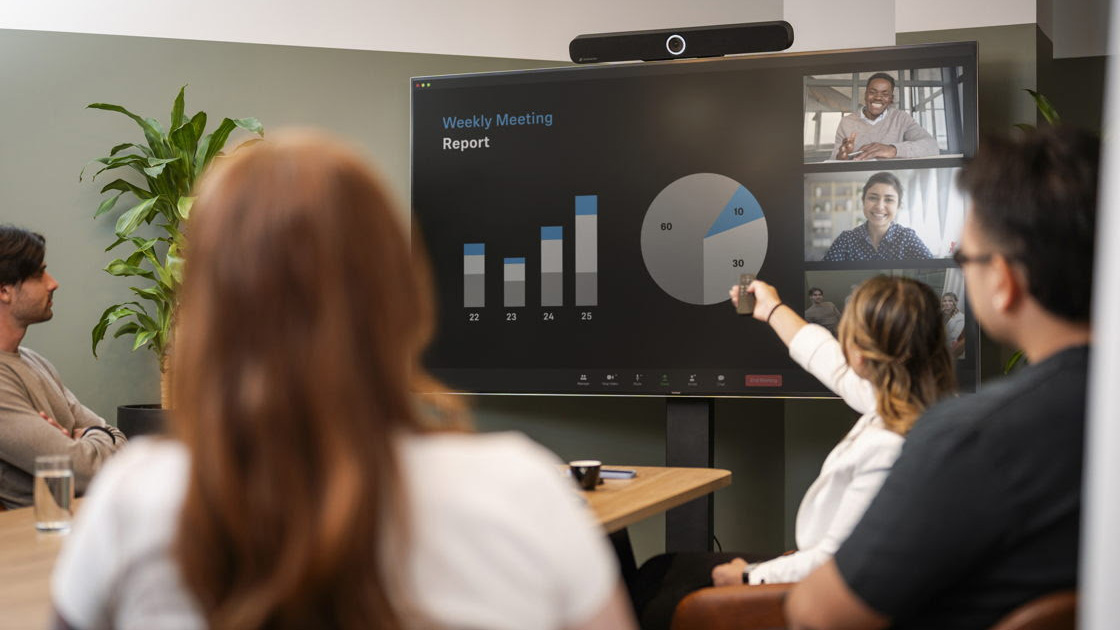Digital Signage: ROI, or ROO? Content Approaches that Improve Results

- Content-—the images and media presented on digital signage displays and in--store messaging sys-tems—is critical in achiev ing this out-of-home and point-of-pur- chase communications medium's capabilities. But content, as network owners and suppliers are increasingly realizing, is more often the silent killer. Technology elements are delivering on the promise of dynamic display, but when content is the weak link in the digital signage chain, the network under-performs, stalls in build-out, and the legitimacy of the entire net work and its overall business strategy are eroded. However, new approaches for providing low-cost, high-impact content for digital signage and in-store display are allowing digital signage and in-store networks to maximize Return on Objectives (ROO) and deliv er on their potential for performance.
The Golf Network (TGN) has proven ROO. TGN targets golf retailers, sporting goods stores, and major golf course pro shops, and provides original content featuring golf tips, golf travel destinations, in-depth technology analysis, golfing celebrities, and health and fitness tips.
Often, the dismay, frustration, and confusion of an under-performing digital signage networks can be addressed by "tuning" the playlist (loop) or improving the content. During August of this year, all three 42" displays in a busy Rexall-Pharma Plus drug store showed a short 30-second loop, which included 20 seconds of no content followed by two five second clips where small private-brand product labels are moved across the screen too fast to be able to read.Death pangs of a network are clear when:
- Little or no improvements in intended results are achieved.
- Awareness of the displays or their value declines on the part of viewers, advertisers or location providers.
- Content is annoying or conflictswith the environment.
- Screens display no content.
- Content is perceived as repetitious.
- Too much content is presented, eroding the expected impacts.
- The network is seen as television(rather than a revenue-generation and branding instrument) in an out-of-home environment.
Content can deliver sales lift, improved branding, and enhance a visit experience along with dozens of other measurable and less tangible benefits. Development in several fundamental areas of "content" has been advancing quietly, yet rapidly. The first of these is in the way in which content extends beyond Return on Investment (ROI) to achieve Return on Objectives (ROO). The second development is in approaches to producing highly effective content at minimal cost.
ROO is increasingly being used to describe the role of digital signage and retail media. The ROO approach uses structures for goal setting, alignment, and focus that allow marketing goals to be achieved through dynamic digital display.
Our company, Alchemy, of St. Joseph Content, has developed the art and science of retail engagement by providing over 20,000 pages of content to Sears, as well as to others such as Wal-Mart and JC Penny. Alchemy's design of the playlist and content for retail media in OfficeMax new store design, 30% of content was given to non-selling spots aimed at improving business practices to gain patronage of a new target demographic. Fifty percent of the playlist was split between price and promotional spots and third-party advertising from selected partners such as HP and Motorola. This content took advantage of digital sig-nage's ability to modify messages to meet changing market conditions and approaches to achieving objectives.
Time is not being sold to vendors, but is being offered to a few selected partners as part of an overall merchandising approach. The Return on Investment is only a part of the planned ROO.
ROO addresses the range of Marketers' business objectives that "content" must deliver using the digital signage or in-store system. These include ROI, brand influence, merchandising, customer loyalty, perception and others.
Digital signage can provide a higher ROO than any other marketing communications medium because of its location, display flexibility, "speed to display," and low cost of content production. Each objective can be articulated with measurement criteria attached, allowing content optimization to further escalate the value of the network. Return on Investment accounts for such elements as sales lift, up-sell, cross-selling, and conversion, as well as endemic, supplier, and third-party advertising and co-op dollars.
A daily selection of features, industry news, and analysis for AV/IT professionals. Sign up below.
Brand influence incorporates, for example, better customer engagement, leveraging an entertainment icon, complex brand communications, regional targeting, live events, simulcasts, live two-way customer service, and interactive connectivity.
Marketers want outcome measures so they can buy communications most effectively. By providing impact measures and an optimization path with cost-effective display, digital signage is positioned to gain the attention and funding that would have gone to other marketing communications approaches.
Content planning uses ears, eyes and audit as useful tools for tuning the play loop. Art Wagner, CEO of the very successful Pharmacy TV Network (PTVN), says, "Content has to be developed for the shopper, not for advertisers or the retailer partners. The best content is developed specifically for the environment in which it will be played."
The science behind creating marketing visuals, such as logos or package designs, applies to digital signage content. Brand names aim for logo recognition with a very brief second visual view, and many achieve this in 1/20 second. The PTVN experience is that "content from leading brands in appropriate areas has more impact than generic unbranded content."
Ads and editorial content are symbiotic on successful network loops. Ads deliver revenue and activate sales, while editorial earns viewer interest. Both forms of content brand the location and the experience.
Wagner says, "Authenticity is a key to engagement and acceptance with shoppers. Content needs to be relevant to the experience the shopper is having. Is a segment on cooking shrimp being shown above bananas a relevant experience?" He adds that, "As with virtually any other medium, there needs to be a clear separation between advertising content and editorial content."
THE RIGHT CONTENT MIX
The Golf Network (TGN) targets golf retailers, sporting goods stores, and major golf course pro shops, and provides original content featuring golf tips, golf travel destinations, in-depth technology analysis, golfing celebrities, and health and fitness tips. Alan Donahue, president and founder of TGN, says, "When we analyzed viewer impact in eight markets, we learned that viewers were attracted to our displays at the point-of-purchase primarily because of the quality and depth of our editorial content. We know that retailers prefer product promotion to move merchandise, but in order to capture and hold the attention of the viewers, we must also provide short, eye-catching content."
Content must achieve business goals at highest value. ("Value" being "Benefits" minus "Costs"), and processes for producing highly effective content, very cost-effectively are advancing.
The double-edged sword of digital signage content is that ads, photos, layouts, and other content created digitally for TV, magazines, websites, posters, etc. is available for digital signage display. But, this content was not created for the digital signage/in-store TV medium or location-based display.
Re-purposing content has largely been motivated by the need to minimize costs, and much of this content re-purposing has been mechanical, such as abstracting part of a larger clip, resizing, reformatting, adding animations, etc. Re-purposing offers high value when the content in the digital signage medium deliver the intended results. Without achieving the results, the economies of repurposing are lost, and a negative branding may even result.
To be a mainstream medium, content for digital signage must be fit into established structures of marketing fulfillment, Generally Accepted Marketing Practices (GAMP).
A marketing campaign (to which digital signage hopes to contribute) articulates customer lifestyle needs and wants and the brand relevance to the customer's life, leading to promotional relevance. Over-arching brand standards lead to Captive Audience Network (C.A.N) standards, which then dictate playlist standards and finally spot standards.
Network owners and brand managers each benefit when digital signage behaves like other well-established marketing devices by integrating with marketing campaign approaches.
More ad revenues result from good quality content. Quality content gets noticed and engages, both of which can be measured. When content quality allows the rate card to move from gross impressions, reach, and eyeballs into engagement and commerce, display inventory is sold more easily and the CPM (cost per thousand) rate increases.
Jeff Collard, CEO of Omnivex, which has provided digital display software used in over 300 networks, says, "Bad content is detrimental to the industry and kills these installations. I don't believe that fixing the content alone will turn installations from losers to winners, but it is probably the best place to start and gives the customer the quickest return. Addressing "content" can then allow other possible problems and opportunities to get attention."
Firms such as Alchemy, which have a deep understanding of marketing communications, creative design, and digital signage, are combining these core competencies to strengthen the "content" link in the digital signage chain. The result is more successful networks through content that better returns on objectives.
The starting and revisit points of digital display value all involve the impact of content. When these are forgotten, discounted, or allowed to erode, the benefits of the digital display program erode as well.
HIGH COSTS = NETWORK FAILURE
Digital display and in-store TV has been dependent on large strides in technology functionality and integration. There is still plenty of technology development ahead, including load, cost/benefit and performance balancing, and interoperability. Some key technology-related issues such as encoding rates and characteristic, file management, network multi-use, and content reuse/repurposing are best addressed where technology meets content. This is where professional digital signage content producers such as Alchemy will work with technology providers.
A key outlook for digital display networks is that objectives will be better clarified prior to investment, and content improvement programs aimed at improving measurable results will be integral to ad placement and network operations.
Digital signage has been a technology "push," but as marketing and communications goals become clearer, market "pull" is increasing. Businesses want to improve brand positioning and customer experience, generate new revenues, or reduce business costs. Retailers and other organizations are pulling digital signage forward so that they can improve display control and the speed of message display.
CONCLUSION
Content is an integral part of the digital display "ecosystem." Improving the productivity and reducing costs of content creation is influencing digital display success. Improving methods of auditing content effectiveness is increasing in importance. The result: Digital signage is a powerful new medium, positioned to make a full frontal attack on the marketing segments that are underperforming. As the new medium in the marketer's toolkit, performance measures are being asked of digital signage. These new measurement tools, linked with content improvement processes, will allow digital signage to increase its positioning as a "most favored" communications approach with marketers.
